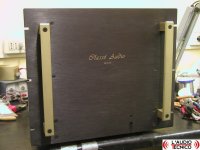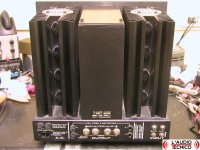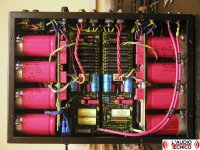When using a bridged amp configuration the impedance that each amp see's is half of what the load is.
It is common for ESL setups to get down to a 2 ohm impedance (or lower) at 20Khz.
Therefore each amp would be seeing a 1 ohm ( or less) load on them at 20Khz.
Some amps can handle this but most don't, and, they don't like this type of situation at all.
At the lower frequency's this is okay as the impedance is much higher, typically below about 10Khz to 5Khz as long as you stay away from transformers core saturation point.
Bridging an amp also doubles its output voltage so if your interface is design to go as low as 20hz with a certain amount of voltage, you must now have to limit the input to the interface at 40Hz if you plan on cranking higher than you would if you were using a single amplifier.
Otherwise would it saturate the interfaces transformer core and this too will cause distortions and overload the amplifier.
FWIW
jer
It is common for ESL setups to get down to a 2 ohm impedance (or lower) at 20Khz.
Therefore each amp would be seeing a 1 ohm ( or less) load on them at 20Khz.
Some amps can handle this but most don't, and, they don't like this type of situation at all.
At the lower frequency's this is okay as the impedance is much higher, typically below about 10Khz to 5Khz as long as you stay away from transformers core saturation point.
Bridging an amp also doubles its output voltage so if your interface is design to go as low as 20hz with a certain amount of voltage, you must now have to limit the input to the interface at 40Hz if you plan on cranking higher than you would if you were using a single amplifier.
Otherwise would it saturate the interfaces transformer core and this too will cause distortions and overload the amplifier.
FWIW
jer
Last edited:
A,b C mods have nothing to do with the Bias....i am just give u info i have found after 30 years of owening Acoustats.....Xs..1+1s..2+2s M2s.. M3..M4..Sp 11...1100...
The new bias is low cost an one way to get the best sound out of any esl.....good luck ....glad thay sound great...
The new bias is low cost an one way to get the best sound out of any esl.....good luck ....glad thay sound great...
Lucky guy who could get a pair of 2+2... Seem great speakers.
Have a look to the EHT supplies on
Audio Transformer
Tremendous improvement on my 1+1's.
Mathieu
Have a look to the EHT supplies on
Audio Transformer
Tremendous improvement on my 1+1's.
Mathieu
Acoustannoy...........Thanks for the link.........yes the outboarding of the bias in All Acoustats well give more than a new amp....new wire...new caps....it the best thing for any esl...in the Acoustats...
In the Stock setup evey time the base tranfourmer get a big base note...it pulls the bias down...what 4-5kv less than 1" from the base res.an the high fre caps...jim would have done it diff....but it cost....we got the deal...Acoustat panels have lasted an still sound great...just littel lov an man...theres not much better...i drive my M3 with a 60year old 50watt tube amp...90-100db output with a bias i can set....
Long Live Acoustat
In the Stock setup evey time the base tranfourmer get a big base note...it pulls the bias down...what 4-5kv less than 1" from the base res.an the high fre caps...jim would have done it diff....but it cost....we got the deal...Acoustat panels have lasted an still sound great...just littel lov an man...theres not much better...i drive my M3 with a 60year old 50watt tube amp...90-100db output with a bias i can set....
Long Live Acoustat
I use two run per + an two -- 24ga solid copper....sweet sound with tubes are Sand amps...well to me...
i got a lot of wire here. 10ga 12ga 14ga was one of the best size wize for sound...when i buy speakers people give the stuf...i was useing Purist Audio... water jacketed wire with my Krell an Apogee setup think it 14ga...out of all for years of diff wire the small sounds best with any of my setup...Now some go to small for me like 36ga but thats about the wire in the Magnepans voice coil...so...but i dont care for the sound..
lot money spent... this 24ga cost the less an sound better....gofig...
but wire is a tuff call i would never say for others.
....lot buzz about coax for ESLs...good luck
i got a lot of wire here. 10ga 12ga 14ga was one of the best size wize for sound...when i buy speakers people give the stuf...i was useing Purist Audio... water jacketed wire with my Krell an Apogee setup think it 14ga...out of all for years of diff wire the small sounds best with any of my setup...Now some go to small for me like 36ga but thats about the wire in the Magnepans voice coil...so...but i dont care for the sound..
lot money spent... this 24ga cost the less an sound better....gofig...
but wire is a tuff call i would never say for others.
....lot buzz about coax for ESLs...good luck
Well, i finally got the 2+2's dialed in. I called in my 19 year old daughter, who has excellent ears.
I had her sit in what would be my place on the couch, and then unplugged the right speaker.
I told her to tell me when the sound sounded best. I turned the left slowly and then she said "go back!'. I turned it the other and she yelled "Stop!". I repeated this on the other side.
It actually worked, sounded pretty full.
I noticed when using MCAAC room correction (probably goes for any room correction scheme) that if the speakers are not aimed correctly, the MCAAC will up the frequencies above 1.5khz.
If the speakers are aimed correctly, it will subtract a little from some of the higher frrequencies and add a little to lower, like a small bump at 40hz.
Sounds great now!
I had her sit in what would be my place on the couch, and then unplugged the right speaker.
I told her to tell me when the sound sounded best. I turned the left slowly and then she said "go back!'. I turned it the other and she yelled "Stop!". I repeated this on the other side.
It actually worked, sounded pretty full.
I noticed when using MCAAC room correction (probably goes for any room correction scheme) that if the speakers are not aimed correctly, the MCAAC will up the frequencies above 1.5khz.
If the speakers are aimed correctly, it will subtract a little from some of the higher frrequencies and add a little to lower, like a small bump at 40hz.
Sounds great now!
Highs either lost or severally attenuated on 1 panel, switched panels, same thing so problem not in arrays but in crossover/pwr supply interface (MK-2123) low freqs may also be attenuated when compared to other interface. When switching panels, the good interface gave a nice spark when discharged but the faulty interface did not spark.
Looking at the meters on my amp (Mac), both channels are outputting the same power to speakers but bad interface has substantially reduced output (volume).
I figure that the problem lies in the bias supply, but then I am no expert and I only fool around when something is not working correctly.
Your thoughts would be appreciated.
Thanks,
Bob Riddle
The schematic I have for MK-2123, rev 1. 5/29/91 does not appear to be exactly like my MK-2123. My schematic shows no fuses in the power line-in but the interface as internal fuses on each leg. From going thru the forum, the 15v ac input which I originally thought a misprint actually is for an upgraded pwr/crossover interface. I have yet to find a schematic for my interfaces.
Looking at the meters on my amp (Mac), both channels are outputting the same power to speakers but bad interface has substantially reduced output (volume).
I figure that the problem lies in the bias supply, but then I am no expert and I only fool around when something is not working correctly.
Your thoughts would be appreciated.
Thanks,
Bob Riddle
The schematic I have for MK-2123, rev 1. 5/29/91 does not appear to be exactly like my MK-2123. My schematic shows no fuses in the power line-in but the interface as internal fuses on each leg. From going thru the forum, the 15v ac input which I originally thought a misprint actually is for an upgraded pwr/crossover interface. I have yet to find a schematic for my interfaces.
I for one dont like the sound of any bridged amps on any speakers,most have a chip in the input for bridging. cost about 50.cent ...
The 121 interfaces are over 30 years old...Just littel lov..an you got some of the best ESLs at any $$$
An the Bias needs to be re-worket most likely...just new diodes an cap in the bias well give more output...
Any amp that wont give you the output you need unbredged.... I would not put on any of my ESLs interfaces transfourmers .... Acoustats...old are new
Others have there input ... there tons of info on Acoustat here....
good luck
Just one man o-pine....... Long live Acoustat
Yes tyu, Acoustat's may be OLD but for me they are still #1 bang for the buck speakers. - - - Long live Acoustat's. - - -
Yes tyu, Acoustat's may be OLD but for me they are still #1 bang for the buck speakers. - - - Long live Acoustat's. - - -
I clicked this thread thinking, I wonder if AAM was Andre... I guess I was wrong
Lucky guy who could get a pair of 2+2... Seem great speakers.
Have a look to the EHT supplies on
Audio Transformer
Tremendous improvement on my 1+1's.
Mathieu
Hey Mathieu i am hearing good things about your 1+1s, i have been talking with Jocelyn now all you need is nice 2x3 steel frames. André
Sorry to say - I am not trying to insult anyone, but the sanders paper about their amplifiers looks like an advertising crap. It gives an impression that amplifier that's not rated at around 100V and hundreds of amps should sound bad.
But where we have any measurements confirming most of conventional amps go into current clipping while playing music and sounds into ESL load ?
Yes the impedance drops considerably with frequency but so drops the average and peak output voltage. At 20 kHz peaks are 10-20db lower with most of music content.
Also although statements like "power amplifier can add over $100 per month to their electric bill" are true in some rare cases its very, very unusual.
A lot of ESLs have comparable efficiency to HiFi cone based systems(let's say, quads etc.).
So there is no understandable argument why it should need more voltage.
Furthermore, with a 73Vrms amp its easy to bring stepup transformer into saturation if its not designed for that voltage and in addition to poor sound quality its possible to do damage to panels or something else.
I cannot agree that a very high voltage & current amplifier is necessary or even recommended in most of cases.
Regards,
Lukas.
Hi Lukas, about your Quote: Also although statements like "power amplifier can add over $100 per month to their electric bill" are true in some rare cases its very, very unusual. I owned this wonderful amp from 1988 to 2000 with a few models of Acoustat's and YES that was the case i also used it to heat my dedicated room in the winter $100 per month was pretty normal for me but the sound of this pure 45 watts per channel pure class A amplifier was worth every dollar.
Classé Audio DR3 - VHC The letters V.H.C. stood for Very High Current
Attachments
Last edited:
Bazukaz, I know we talked about the Sanders amps a while back, but the more I hear it, the more I like...yeah, it may have enough cajones to never clip, but it is also doing something sweet...I want to try it out on some Maggies and my CLS next.
On a similar topic, I will be building a Leach amp soon, and can't help but think the Sanders ESL is a modified high rail, 2x more output devices Leach amp?? I heard a Leach a few weeks back was was very impressed...I was always a Class A amp guy until I heard the Leach and the Sanders amp - both class A/B...
On a similar topic, I will be building a Leach amp soon, and can't help but think the Sanders ESL is a modified high rail, 2x more output devices Leach amp?? I heard a Leach a few weeks back was was very impressed...I was always a Class A amp guy until I heard the Leach and the Sanders amp - both class A/B...
I am starting to think these 2+2's are like real estate- location, location, location!
I have the right speaker 37" away from the back wall, 14" away from side wall. The left is also 37" away from back wall, no wall to the left of it, got space there.
I like the bass, drums, bass guitar come through well. It is just that deeper notes, like produced with a synthesizer don't come through.
It seems like those much lower notes are being cancelled out.
I have seen the hint at about hanging up tapestries behind them, but would like to do better.
What I am thinking about is making bass traps, get the wood from the hardware store.
Make them about the same length and height as the speakers, outside would be white cloth to match the paint on the walls, under the cloth, I'd put a layer of fiberglass, then hang each one behind the speaker. I figure they'd absorb the a good portion of the rear wave of the speakers, just worried that might take away from their imaging.
Anyone tried anything like this?
I have the right speaker 37" away from the back wall, 14" away from side wall. The left is also 37" away from back wall, no wall to the left of it, got space there.
I like the bass, drums, bass guitar come through well. It is just that deeper notes, like produced with a synthesizer don't come through.
It seems like those much lower notes are being cancelled out.
I have seen the hint at about hanging up tapestries behind them, but would like to do better.
What I am thinking about is making bass traps, get the wood from the hardware store.
Make them about the same length and height as the speakers, outside would be white cloth to match the paint on the walls, under the cloth, I'd put a layer of fiberglass, then hang each one behind the speaker. I figure they'd absorb the a good portion of the rear wave of the speakers, just worried that might take away from their imaging.
Anyone tried anything like this?
I clicked this thread thinking, I wonder if AAM was Andre... I guess I was wrong
AcoustatAnswerMan is the one and only Mr.Andy Szabo
Spectra 8800
Just a question on these and other Spectra users, I was wanting to confirm if the full range section was in the, I think traditional, biased to the inside edge, or had been configured in a more central, original quad type arrangement? With 4 panels wide and "8" segments in might be easy to configure as a double width central section and a mirror image Spectra44 arrangement on each side. Of course the other option would be a 4 or 5 stage, rather than 3 stager.
But I am guessing and would be fascinated to know.
Cheers
Gnnett
Hi noelm, the steel frames was a major change in both my 1+1s and my friend Jocelyn's Spectra 8800s 200 pounds for the baby and close to 800 for the dad.
Just a question on these and other Spectra users, I was wanting to confirm if the full range section was in the, I think traditional, biased to the inside edge, or had been configured in a more central, original quad type arrangement? With 4 panels wide and "8" segments in might be easy to configure as a double width central section and a mirror image Spectra44 arrangement on each side. Of course the other option would be a 4 or 5 stage, rather than 3 stager.
But I am guessing and would be fascinated to know.
Cheers
Gnnett
What model acoustats did Steve Jobs have?
Isnt this picture interesting - The peleton - Planar Speaker Asylum
Isnt this picture interesting - The peleton - Planar Speaker Asylum
Does anyone know if the Direct Drive Tube Servo amps can be used on the Spectra Series?
Thanks for any + all replies!
Ken
Theoretically yes, but it's not a plug-n-play scenario. Not only would you need to construct the sectoring resistors to feed the different segments of the Spectra, you would also need to significantly alter the equalization of the amp to match the differing areas for highs, mids and lows. This would not be an easy job, and I'm not entirely sure it could be done.
- Home
- Loudspeakers
- Planars & Exotics
- Acoustat Answer Man is here


